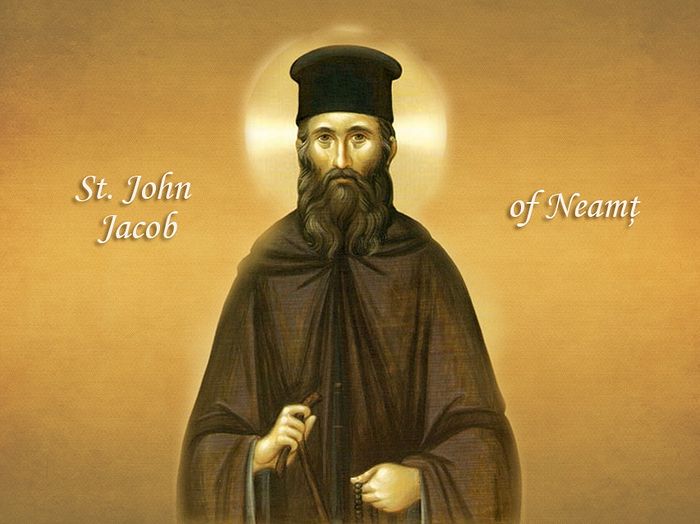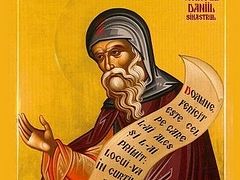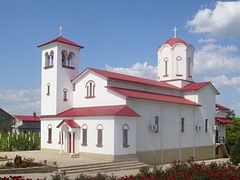Source: Basilica News Agency
January 26, 2016
The Patriarchate of Jerusalem will formally recognize on Sunday, January 31 the sainthood of the venerable Romanian father John Jacob of Neamţ, or the Hozevite, as reported by the representative of the Romanian Patriarchate to the Holy Land, V. Rev. Archimandrite Teofil Anăstăsoaie. The Romanian Patriarchate will be represented by a delegation led by His Grace Timotei of Prahova, Vicar Bishop to the Archdiocese of Bucharest.
The canonization ceremony of Venerable John Jacob will take place at St. George the Hozevite Monastery, near Jericho, Israel. On this occasion, His Beatitude Theophilos III, Patriarch of Jerusalem and all Palestine, will officiate the Divine Liturgy. Many hierarchs, clergy and faithful are expected to attend the canonization ceremony.
The Holy Synod of the Romanian Orthodox Church, during its working session of June 20, 1992, canonized the venerable father John Jacob of Neamţ, fixing his feast day on August 5, the day of his passing to the Lord.
The Holy Synod of the Patriarchate of Jerusalem decided during its 2015 autumn session to recognize the sainthood of the venerable Romanian father John Jacob.
The Life of St John Jacob
Saint John Jacob of Neamţ was born on July 23, 1913 in Crăiniceni village, Horodiştea commune, former Dorohoi county, to a family of religious peasants, Maxim and Ecaterina, as the only child to his parents. He was baptised Elijah and turned out to be a child chosen and blessed by God.
Six months after he was born, his mother, who was in poor health, fell asleep in the Lord and left the child to his grandmother Maria to take care of him. After two years, his father died too, in war, in the autumn of 1916, so that the child was left in the care of close relatives. He attended the first years of school in his native village and then the secondary school at Lipcani-Hotin and high school at Cozmeni-Cernăuţi. He was the best pupil at the school.
In the summer of 1932 his relatives wanted him to attend the courses of the faculty of theology in Chernivtsi (now in Ukraine) to become a priest, but he felt God called him to a higher life and told them, "No, I want to become a monastic!” One year later, young Elijah was working in the field and praying to God to show him which way to follow. Suddenly, he heard a voice telling him: "the monastery!" He had no peace in his soul from that time, until, having taken the blessing of his father confessor, Blessed John took his holy books, the cross and the icon of the Mother of God from his childhood home, and guided by the Holy Spirit, on a Sunday, he joined the monastic community of Neamţ Monastery. The abbot of the monastery, Bishop Nicodemus, received him with much love and after instructing him to go and pray to the wonderworking icon of the Mother of God in the church, he sent him to work in the nursery and the library of the monastery. He was very silent, obedient and devoted.
From 1934 to 1935 he served in the military in Dorohoi as a male nurse, showing much compassion to the sick, and was loved by all those around. In the autumn of 1935 he returned to the community of Neamţ Monastery and continued the same service as librarian and male nurse at the monastery’s infirmary. All those around him benefited from his humbleness, kindness, and love, and believed him to be chosen by God.
On April 8, 1936, Great Wednesday, the blessed rassaphore John Jacob was tonsured into monasticism by the hierarch Valerie Moglan, the new abbot of the great lavra, by the monastic name of John, together with two other rassaphores. As he wished to live an ascetic life and longing for Christ and the holy places where the Lord was born, suffered and resurrected, the blessed monk John Jacob left for the Holy Land together with two other monks from the lavra, Claudie and Damaschin. After they prayed at all the holy places and venerated the Cross of Golgotha and the Holy Sepulchre the three monks retired to spend the winter with the community of Saint Sava Monastery, in the Jordan desert. Afterwards his companions returned to Neamţ Monastery, while the blessed monk John Jacob continued living at Saint Sava Monastery near Bethlehem for ten years, suffering hard temptations, diseases and trials coming both from people and from demons.
His first task within the community of Saint Sava Monastery was that of starosta. The pious John had great devotion for the Church and for the holy services. He made prosphora, and cleaned the nave and rang the bells for the services. He also kept an atmosphere of love, lowliness and mercy towards all. He also served as the nurse of the monastery and took good care of the monks with great love, as well as of many Arabs and Bedouins, of the sick, and of the war wounded brought to the infirmary of the monastery. This is why they all loved him and wanted contact with him.
His father confessor was hieroschema-monk Sava, a great adviser of souls, Macedonian by origin, who could speak Romanian, and who took Confession from all the Romanian monks who lived in the Holy Land. Thus, during the day he was in the service of the community and of the sick and at night he was alone in his cell where he said many prayers, made prostrations, shed tears and read from the Holy Gospel and from the writings of the Holy Fathers. He had a good command of the Greek language so that he translated some outstanding patristic passages used to spiritually feed himself and those who came to visit him. He also had the gift of writing spiritual instructions and poems which he sent to his brethren from the Holy Land or gave to the Romanian pilgrims who came to pray at the Holy Sepulchre.
From 1939-1940, the blessed hermit John Jacob lived together with another Romanian disciple in a cave in the desert of Qumran, close to the Dead Sea. There he met monk Ioannikios Pârâială who became his faithful disciple until his death. As a hermit he ate only rusks and a few fruits. He used to pray at night, alone, suffering many temptations.
From 1940-1941, due to the war, the venerable John stayed together with several monks from the Holy Land in a camp at the Olives Mountain. After he was released, he went back to Saint Sava Monastery and continued to practice the same spiritual obedience and efforts.
On May 13, 1947, by the agreement of the Patriarchate of Jerusalem and the blessing of the Patriarch of Romania, he was ordained as a deacon in the church of the Holy Sepulchre, following the recommendation of Archimandrite Victorin Ursache, the superior of the Romanian Pilgrim Hostel in Jerusalem. That same year John Jacob was ordained to the priesthood in the church of the Holy Sepulchre by the hierarch Irinarh from the Patriarchate of Jerusalem and appointed by the Romanian Patriarchate igumen of the Romanian Skete of Saint John the Baptist in the Jordan Valley, close to the place where Jesus Christ, our Lord, was baptised. For five years, as long as this task lasted, John Jacob celebrated all the services in the Romanian language almost every day, translated many pages from the Holy Fathers that comprised teachings for monks and pilgrims, wrote a rich book of spiritual poems, renewed the cells and the church skete, and most of all the spiritual life of the skete, met with Romanian pilgrims whose confessions he heard, administered Holy Communion and gave saving advice for their soul. But at night, unknowingly, he prayed alone in his cell, or went to pray in the Jordan Valley, trying to follow as much as he could the example of Venerable Mary the Egyptian. His only constant disciple was monk Ioannikios, as well as some Romanian old nuns, Melania, Natalia, Galina, Casiana and Magdalena, who were his spiritual daughters under his guidance.
In November 1952, John the Hermit retired from the igumen position and joined, together with his disciple Ioannikios, the community of Saint George the Hosevite Monastery in Hoseva desert, in the valley of Cherit (or Horat) River. After one year he and his disciple retired to a cave nearby called Saint Ana’s Cell, where, according to tradition, she prayed God to give her a child. A Cypriote monk named Paul was living in another cave nearby. There Saint John the Hermit and his disciple lived for 7 years in permanent prayers, night vigils, long fasting, shed tears, meditation and spiritual aspirations, suffering all kinds of temptations, pains, shortages, fighting against the devils, in total seclusion, glorifying Christ and praising the Triune God. His cave was hard to reach, with a high ladder, and he did not receive anybody there, communicating with those who came to him especially through prayer, through spiritual writings and through his disciple. At the great feasts and in fasting times the saint celebrated the Divine Liturgy in the chapel of Saint Ana’s cave, together with his disciple, and both received the Body and Blood of Christ, thanking God for everything. During the day, when he had time, he wrote religious poems and translated patristic writings from Greek. He ate only once a day, rusks, olives, figs, and drank a little water, and at night he slept on a board with a stone as his pillow.
In the summer of 1960 he was sick but suffered with much patience. Feeling his death was close, on Wednesday, August 4 he received Holy Communion and on Thursday morning, at 5:00 he reposed in the Lord at only 47 years old. After three days he was buried in the same cave by the igumen of Saint George Monastery, Archimandrite Amphilochius, and after 20 years, on August 8, 1980, his body was found incorrupt, without decay, spreading a pleasant fragrance, showing that he was glorified by God Who included him in the host of the saints due to his spiritual diligences and the holiness of his life. All those around were filled with great spiritual joy.
On August 15, 1980, the same igumen prepared a shrine carved in cypress wood where he laid him with great respect and took him in procession to the church dedicated to Saint Stephan in the precincts where his relics were laid, in the same place of worship where the relics of Saint George the Hosevite are to be found.
Pilgrims have come to pray at his relics ever since, asking for his help, which all those who pray to him receive. Taking into account the holiness of the life of the pious John Jacob and seeing his holy relics, the Holy Synod of the Romanian Orthodox Church included him among the saints on June 20, 1992 by the name of Saint John Jacob of Neamţ, celebrated on August 5, the date of his passing away in eternity.
Through his holy prayers, Lord Jesus Christ, our God, have mercy on us. Amen.
Troparion, plagal 4 tone 8:
In you, through zeal the one created in the image of God was saved, oh Father, for forsaking the world and leaving your homeland, you took up Christ's cross, and you dwelt in labors in the valley of Jordan. Wherefore, oh Righteous Father John, your spirit rejoices now with the angels. Intercede with Christ our God to save our souls.




